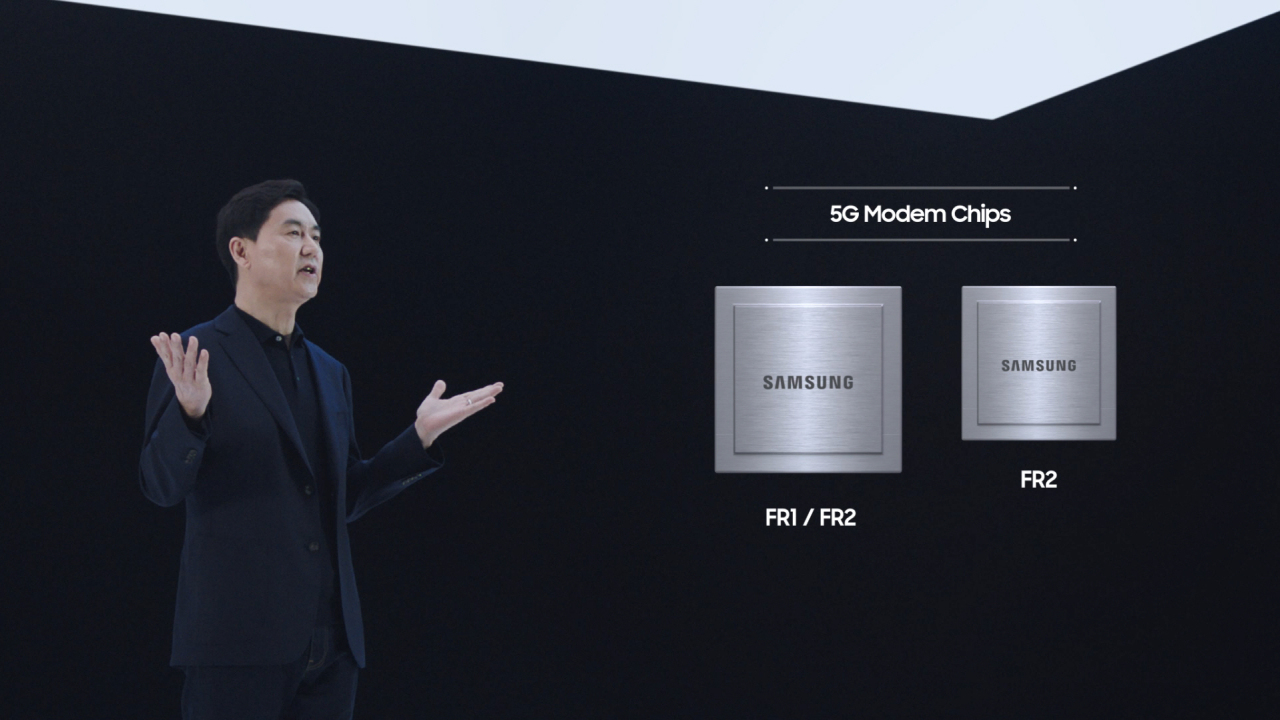 |
Cheun Kyung-whoon, president and head of the networks business at Samsung, presents new 5G chipsets during a virtual event on Tuesday. (Samsung Electronics) |
Samsung Electronics on Tuesday unveiled a set of innovative 5G solutions, three chips and one antenna radio, at its first virtual showcase event.
Called “Samsung Networks: Redefined,” the show was streamed live from Seoul at 11 p.m., Korean time. It was the first event hosted by Samsung’s network business.
The virtual event was held ahead of Mobile World Congress 2021, an offline event slated for June 28 in Barcelona, Spain. Last year’s congress was canceled due to the COVID-19 pandemic.
Samsung decided to hold its own event separately to showcase its latest 5G technologies.
At the Tuesday event, Samsung Networks highlighted key developments in its global expansion in recent years, which included the successful delivery of over 4 million 5G-ready radios around the world.
Samsung focused on how it is advancing virtualization to drive next-generation networks, and leading 5G radio innovation by embedding the company’s latest in-house chipsets into its radios.
“We are delighted to discuss the infinite possibilities of wireless technology, as we continue our 5G journey, and pave the way towards the next phase of 5G,” said Cheun Kyung-whoon, president and head of the networks business at Samsung. “Samsung’s 5G vision includes bringing together the best global expertise and technical insights that can help operators and consumers take full advantage of 5G benefits. We’re grateful that our customers and partners have joined us on this journey, and look forward to achieving many more 5G milestones together.”
During the event, Samsung unveiled three 5G chipsets: a third-generation mmWave radio frequency integrated circuit chip, a second-generation 5G modem system-on-chip and a digital front end-RFIC integrated chip.
Samsung’s third-generation RFIC chip supports both the 28 gigahertz and 39 GHz spectrums, and will be embedded in Samsung’s next-generation 5G Compact Macro.
The chip incorporates advanced technology that reduces antenna size by nearly 50 percent, maximizing the 5G radio’s interior space. Moreover, the latest RFIC chip improves power consumption, resulting in a more compact, lightweight 5G radio.
The second-generation 5G Modem SoC will double the capacity of Samsung’s forthcoming baseband unit, while cutting power consumption in half compared with the previous generation.
Moreover, supporting both the below-6 GHz and mmWave spectrums, it offers beamforming and increased power efficiency for Samsung’s next-generation 5G Compact Macro and Massive MIMO radios, while reducing the size of both.
The latest DFE-RFIC integrated chip combines RFIC and DFE functions for both the below-6 GHz and mmWave spectrums.
By integrating these functions, the chip not only doubles frequency bandwidth, but also reduces the size and increases output power for Samsung’s next-generation solutions, including the 5G Compact Macro.
“These newly unveiled chipsets are the fundamental component of our state-of-the-art 5G solutions, developed through a long-standing R&D effort that enables Samsung to be at the forefront of delivering cutting-edge 5G technologies,” said Lee June-hee, executive vice president at Samsung. “As one of the largest semiconductor companies in the world, we are committed to developing the most innovative chips for the next phase of 5G advancement, integrated with the features mobile operators seek to stay competitive.”
 |
Cheun Kyung-whoon, president and head of the networks business at Samsung (Samsung Electronics) |
On Tuesday, Samsung presented its new One Antenna Radio solution too.
The new One Antenna Radio features integrated antennas, providing operators with the ability to simplify and speed up 5G installations by consolidating a 3.5 GHz Massive MIMO radio with low-band and midband passive antennas into a single form factor.
As operators continue to extend their 5G coverage, one challenge they face is the space and footprint restrictions at sites and on towers.
Samsung’s all-in-one radio will address varied environmental and site demands -- making installation easier, saving space and reducing operating expenses, the company said.
The new radio will become part of Samsung’s radio access network portfolio in early 2022, initially targeting the European market.
“We are proud to introduce our One Antenna Radio to provide industry-leading performance that’s designed to address various deployment environments,” said Roh Won-il, senior vice president at Samsung.
“Recognizing that mounting hardware, cabling, crew site time and space limitations are a challenge for most operators, we created a solution to help tackle this issue, and expand deployment boundaries.”
By Song Su-hyun (
song@heraldcorp.com)









![[Herald Interview] How Gopizza got big in India](http://res.heraldm.com/phpwas/restmb_idxmake.php?idx=644&simg=/content/image/2024/11/20/20241120050057_0.jpg)